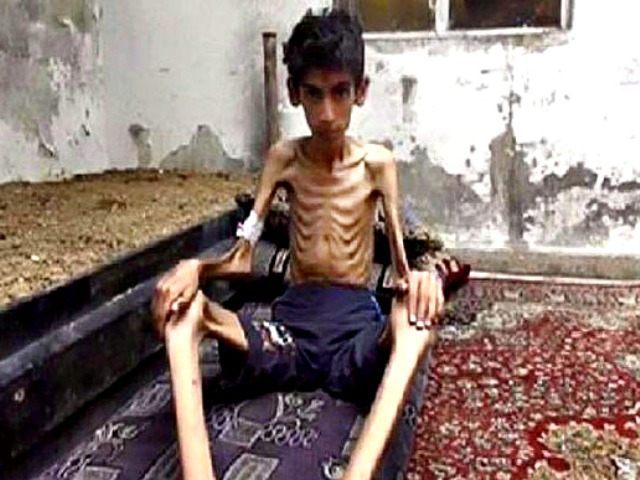Syrian dictator Bashar al-Assad, who is being supported by Russia and Iran, is reportedly starving the residents of a besieged mountain town located northwest of Syria’s capital, Damascus, as the freezing and hungry townspeople prepare to endure a cold winter.
Up to 30,000 people have been trapped in the mountain town of Madaya, which is surrounded by land mines, since July 2015, reports the Guardian.
“Residents of a Syrian town a few dozen miles from the capital, Damascus, say they are dying of starvation as a result of a months-long siege by forces loyal to the government of Bashar al-Assad,” notes the report.
Some Families have resorted to “eating leaves, grasses and water flavored with spices in the town of Madaya, where rice is sold by the gram because a kilogram costs as much as $250,” reveals the Guardian, adding that others “have killed and eaten their pets.”
The Foreign Desk reports that the residents are calling on the international community to help provide aid as the starving and freezing cold residents prepare to endure a brutal winter.
“Here, we no longer call on anyone,” Louay, a social worker from the town told the Guardian. “We have called for help so many times and nobody has heard us. But we want to ask the officials and decision-makers out there, if you were in this position, and your children were dying from hunger in front of you, what would be your reaction to the world outside that let you down? Don’t forget to ask your readers this question.”
“Whether you are a man, woman, child, whether you’re 70 or 20 years old, you will have lost about 15 kg (33lbs) of your weight,” Ebrahem Abbass, a former Syrian Army Sergeant, also told the Guardian.
“People are dying in slow motion,” added Louay. “We had some flowers growing in pots at home. Yesterday, we picked the petals and ate them, but they were bitter, awful.”
The social worker “sent pictures of emaciated bodies of several elderly men, recent casualties of the starvation,” reports the Guardian.
“We used to say nobody could ever die from hunger, but we have seen people actually die of hunger,” he told the UK news outlet.
Meanwhile, activists from Madaya sent pictures of children going hungry, including one of a starving kid being pushed in a buggy because his too weak to walk.
“Others who can still move around, and should normally be in school, are risking their lives trying to collect plants in minefields around the town’s outskirts, and several have lost limbs,” the Guardian quoted residents as saying.
“It was not possible to verify their claims because of the siege, but several independent accounts were consistent in describing life in a town desperately short of food, medicine and electricity,” acknowledged the Guardian.
An aid official who visited Madaya in October told UK news outlet that he witnessed “deep suffering.”
“There was a very dramatic appeal from the children… the children should not be suffering,” he said.
Tens of thousands of people have been trapped in the town, which is under a tight siege by pro-Assad troops.
“They say they are being treated as pawns in a complicated power play, punished for the suffering of two villages hundreds of miles away at the hand of anti-government troops,” points out the Guardian.
A rebel coalition called Jaysh al-Fateh seized large swaths of northwestern Syria from the Assad regime last spring, surrounding two Shiite enclaves in Syria’s Idlib province called Fua and Kefraya, where residents are also enduring a brutal siege.
“Assad’s forces are now starving Madaya and neighboring Zabadani, once a stronghold of the opposition, after a punishing six-month campaign,” declares the Guardian.
“Under a ceasefire deal, foreign backers of the government and the opposition are attempting to orchestrate a population swap, essentially a peaceful ‘sectarian cleansing,’” adds the report.
Although the article does not name the “foreign backers,” the Assad regime is known to receive major support from Iran and Russia.
Late last September, Russia began launching airstrikes against opposition groups in Syria, including some backed by the United States. Iran has been providing military support to the Assad regime, through its proxies such as the Shiite terrorist group Hezbollah and the Iranian Revolutionary Guard Corps-Quds Force (IRGC-QF).
So far the so-called foreign backers have only managed to evacuate wounded individuals on both sides — the government and the opposition — as well as provide safe passage for a single aid delivery in October.
“That allowed convoys to reach Madaya, Zabadani, Fua and Kefraya simultaneously, but supplies only lasted a few days,” the Guardian quoted residents as saying.
